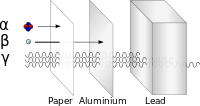
Photo from wikipedia
BACKGROUND To develop experience, orthopaedic surgeons train their own proprioception to detect torque during screw insertion. This experience is acquired over time and when implanting conventional/non-locked screws in osteopenic cancellous… Click to show full abstract
BACKGROUND To develop experience, orthopaedic surgeons train their own proprioception to detect torque during screw insertion. This experience is acquired over time and when implanting conventional/non-locked screws in osteopenic cancellous bone the experienced surgeon still strips between 38 and 45%. Technology needs to be investigated to reduce stripping rates. Acoustic-Emission technology has the ability to detect stress wave energy transmitted through a screw during insertion into synthetic bone. Our hypothesis is Acoustic-Emission waves can be detected through standard orthopaedic screwdrivers while advancing screws through purchase and overtightening in cancellous human bone with different bone mineral densities replicating the clinical state. METHODS 77 non-locking 4 mm and 6.5 mm diameter cancellous bone screws were inserted through to stripping into the lateral condylar area of 6 pairs of embalmed distal femurs. Specimens had varying degrees of bone mineral density determined by quantitative CT. Acoustic-Emission energy and axial force were detected for each test. RESULTS The tests showed a significant high correlation between bone mineral density and Acoustic-Emission energy with R = 0.74. A linear regression model with the mean stripping load as the dependent variable and mean Acoustic-Emission energy, bone mineral densities and screw size as the independent variables resulted in r2 = 0.94. INTERPRETATION This experiment succeeded in testing real time Acoustic-Emission monitoring of screw purchase and overtightening in human bone. Acoustic-Emission energy and axial compressive force have positive high correlation to bone mineral density. The purpose is to develop a known technology and apply it to improve the bone-metal construct strength by reducing human error of screw overtightening.
Journal Title: Clinical biomechanics
Year Published: 2020
Link to full text (if available)
Share on Social Media: Sign Up to like & get
recommendations!